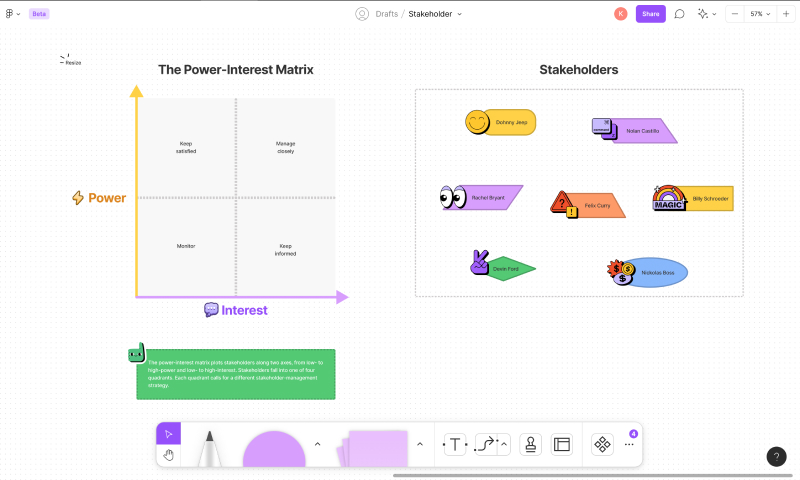What is a stakeholder map? What is stakeholder mapping?
What is stakeholder analysis? In a nutshell, it's a way of visually organizing a company's stakeholders, products, projects, or ideas.
Stakeholder mapping visually represents all the people who influence and are influenced by the company, product, project, or idea. It presents their interrelationships and dependencies.
Now that we have a vague outline of the problem, let's move on to the details that will give us a better understanding of how to create a stakeholder map and its benefits.
What are stakeholders?
A stakeholder is a person or group of people but also an entity (e.g., a company, an organization, an office) that impacts the goals, operations, and performance of a project, enterprise, product, etc.
By impact, we mean all kinds of influence — actual and potential — in the form of reactions, opinions, evaluations, recommendations, negotiations, and complaints.
The stakeholder doesn't have to be, and often isn't, closely related to a company (e.g., through employment or owned shares—stocks).

What is the difference between a stakeholder and a shareholder?
Stakeholders shouldn't be mistaken for shareholders. Although both parties are involved with a company in some way, they differ.
The most significant difference is that shareholders own a part of an organization through stock ownership. They're interested in how the business performs, but they don't have a direct influence on the current projects. However, some of them hold power in terms of the company's policies.
On the other hand, stakeholders have a "stake" in the current project and are directly impacted by it. They can be company employees or external entities hired for a project.
Benefits of stakeholder mapping
Stakeholder mapping allows us to organize and identify key stakeholders, making stakeholder management much easier and seamless. Thanks to it, we can determine all necessary parties crucial to our project's success.
What are the specific benefits stakeholder mapping can bring us?
Finding which stakeholders have the most influence and interest
Thanks to stakeholder maps, we can visualize which stakeholders have the most influence and interest in a project. Thanks to that, we can focus on common goals and expectations and steer our project in that direction.
Determining which parties will benefit the most from a project
Stakeholder mapping helps reveal who will benefit from a project, whether these are stakeholders directly involved with a company or those beyond it, like users.
When we determine that a particular stakeholder within a company will benefit significantly from a current project, we can use that information to secure more resources.
Similarly, once we know what users need and expect, we can focus on designing marketing campaigns that are precisely targeted toward them.
Identifying resources
Stakeholder mapping helps us see the scope of influence of various parties, which lets us determine resource availability. It helps us decide who would be helpful to our project team.
Analysis of company's stakeholders: Internal and external stakeholders
In the most general sense, stakeholders can be divided into two types: internal and external. Depending on the industry, the structure of the company, the level of generality, and the level of detail of the stakeholder map, the stakeholder structure will look slightly different.
It will look different for a project and the whole company. Nevertheless, internal stakeholders are directly and indirectly involved in a project.
A stakeholder analysis (analysis of project stakeholders) in the case of digital products should include the following:
- Owners and originators
- Programmers/developers
- Product owners
- UX/UI specialists
- Researchers
- Legal department
- Regulators
- IT infrastructure providers
- External APIs or integrators
- Other service providers
- Users
External stakeholders are individuals and entities that will be affected by a project, although they aren't directly involved in its creation. The distance that separates them, the roles they play, and the influence, involvement, and interest they feel and manifest will vary.
By considering the criteria of strength of influence and the level and intensity of interest in the project, we can distinguish four types of stakeholders.
Types of stakeholders based on influence strength:
- Stakeholders with a lot of influence and little interest in the company or project.
- Stakeholders with small influence and strong interest in the company or project.
- Stakeholders with a lot of influence and strong interest in the company or project.
- Stakeholders with small influence and little interest in the company or project.
What is stakeholder mapping, and why is stakeholder mapping important?
Stakeholder mapping is simultaneously a process and a tool for categorizing stakeholders, identifying their relationships and the dependencies between them, and linking them into groups (e.g., with a similar power of influence). It allows us to determine what interests each group represents, their role in the organization, and their goals and expectations.
It's an essential step of stakeholder management.

An important advantage of mapping stakeholders is capturing power relationships and their consequences for accelerating or slowing down a company's development.
The stakeholder map also helps to organize goals and methods. It's a beneficial tool used in:
- Analysis of conditions, company dependencies
- Decision-making
- Negotiation
- Creation of strategy
- Discussion of choices.
We can distinguish four stages of the stakeholder mapping process:
- Identification stage: In this stage, we identify stakeholders, that is, people, institutions, and organizations that are affected by a project we work on.
- Categorization stage: During this stage, we analyze the relations, interests, roles, positions, and resources of individual stakeholders.
- Mapping stage: We map stakeholders by visualizing their relations and identifying potential problems.
- Prioritization stage: In this stage, we hierarchize and prioritize stakeholders, their importance, roles, issues, and goals.
The essence and most important issue in the stakeholder mapping process is the availability of information about stakeholders and awareness of their goals and capabilities. The criteria adopted in the analysis process that establish the hierarchy and "reveal" relationships and dependencies are no less important.
It's worth remembering that a change in criteria will change the importance of a given stakeholder to the company.
How to create a stakeholder map?
As mentioned above, the stakeholder map is created based on a list of stakeholders, which is never complete. Because of a specific goal, it will look slightly different each time.
Changing objectives, corporate strategies (internal changes), and market, political, macro, and micro-economic changes (external changes) can significantly modify it.
With an up-to-date list of stakeholders, we can categorize them following specific criteria (e.g., power, interest). With stakeholders sorted by specific criteria and according to their importance in a given group, we can move on to creating communication strategies for each group.
Appropriate communication helps increase stakeholder engagement. Within the communication strategy, it is possible to develop the language of communication and differentiate stakeholders by the accessibility criterion and detail of the information provided to them.

Stakeholder maps come in many variants. Hence, creating them based on relevant templates that fit the short-term goals is best.
The most popular variant is a matrix, in which stakeholders are placed in one of four fields, determined by the intensity of a trait—influence or interest.
Tools for creating stakeholder maps
Naturally, we can create a stakeholder map using traditional means, such as sticky notes and a pen. However, digital tools are on the market that will make this process much smoother and more enjoyable and facilitate sharing it with other relevant parties.
That's why we decided to include some examples in no particular order.
Miro
Miro is an online workspace that facilitates collaboration and development work. It offers tools for process mapping, wireframing, content data and visualization, and more.
When it comes to mapping, Miro provides a ready-to-use stakeholder map template. It has various features that enable us to edit the map, customize it using diagrams, allow real-time collaboration with team members, and add any necessary annotations and comments.
Lucidspark
Lucidspark offers a stakeholder mapping tool as a virtual whiteboard, allowing us and our team to collaborate.
Their tool allows for customizing a ready-made template or creating a stakeholder map from scratch. It offers features such as sticky notes, images, freehand drawing, and Magic Shape. Moreover, it allows users to upload outside resources and integrate them with third-party applications such as Google Drive, Slack, and the Lucidspark Zoom application.
Canva
Canva offers a stakeholder map maker that will make our project management process effective and efficient.
Its functionalities include multiple graphs, various ready-made templates, data visualization, the option to download and share files, embed stakeholder maps in reports and presentations, and a drag-and-drop function that makes the tool easy to use.
Stakeholder mapping: Best practices
In the article "Stakeholder Mapping 101: A Quick Guide to Stakeholder Maps," we can read about helpful best practices for stakeholder mapping. With these best practices in mind, we can efficiently and effectively communicate with our stakeholders.
Inclusivity
It's essential to ensure that communication between a company and stakeholders is inclusive. What does that mean? We should be mindful of stakeholders' diverse cultures and languages. We should ensure that the messages are tailored to them and fulfill their individual expectations.
Clear communication
We should ensure our reports and visualizations are understandable and free of hard-to-understand jargon. We should clearly emphasize significant data and relations and watch out for stakeholder feedback that can help us improve communication and decision-making.
Openness and honesty
Transparency in communication between a company and stakeholders is crucial. We should never hide any information, no matter how bad. Sooner or later, it will come to light, and it's best to address it with stakeholders as soon as possible to get the situation under control and aligned with everyone's expectations.
Availability
Staying available means providing stakeholders with a direct line of communication with us. This will ensure that we can address their questions, concerns, and overall feedback in a timely manner. It will also help them feel more involved with a project.
Stakeholder map: Key questions
When creating a stakeholder map, we should pay particular attention to the following questions and find the most detailed answers for them:
- Who has the most influence on the company or the project?
- On whom does the company or the project have the most significant impact?
- What resources, power, interest, and influence do the various stakeholders have?
- What is the role of each stakeholder?
- Which stakeholder is the most emotionally involved?
- What motivates individual stakeholders?
What is stakeholder mapping? Summary
Stakeholder mapping is a beneficial tool for our project and stakeholder management efforts. It allows us to identify key stakeholders and assign them to groups based on their influence and interest. Thanks to a stakeholder map, we know who needs to be regularly updated on the project's progress, who can secure us the necessary resources, and to who we should address our marketing materials.
The advantages of stakeholder mapping are hard to ignore. It lets us maintain alignment with the company's and stakeholders' goals and expectations. It provides us with necessary information on who to contact in case of any issues or when important announcements need to be made.
With multiple tools available on the market, we can create a practical and useful stakeholder map that will facilitate and visualize many processes.






